#neutrophil activity
Explore tagged Tumblr posts
Text
Some Allergy Vocabulary

for your next poem/story
Allergic crease - A crease or pale line that develops across the lower part of the nose because of frequent upward wiping of the nose.
Angioedema - (or edema) Swelling
Dander - Material that is shed from the body of humans and animals that have fur, hair, or feathers.
Dust mite - A small mite invisible to the naked eye. Dust mites are widely distributed in homes and dust mite allergy is a major cause of asthma and allergic rhinitis (hay fever).
Elemental diet - A diet of predigested liquid containing amino acids, vitamins, minerals, electrolytes, and glucose.
Eosinophils - Cells that circulate in the blood. They attack tissues at the site of an allergic reaction causing damage.
Erythema - Reddening of the skin.
Macrophages - Scavengers whose job is to engulf or eat up infecting germs and even infected cells. Macrophages also help to overcome infection by secreting signals that help activate other cell types to fight against infections.
Monocytes - Cells that circulate in the blood and become macrophages in the tissues. These cells are very important in alerting the immune system about an infection.
Neutropenia - A condition that results when the body does not have enough neutrophils, an important white blood cell that fights infections. The lower your neutrophil count, the more vulnerable you are to infectious diseases.
Pollen count - (or a mold count) Is based on the measurement of the number of grains of pollen or mold spores in a cubic meter of the air. The higher the count, the greater the chance that people suffering from hay fever will experience symptoms when they are outdoors or exposed to outdoor air.
Pruritus - Itching
Urticaria - The medical word for hives, which are itchy, raised lumps that can vary in position from hour to hour or day to day.
Wheal - A raised whitish itchy lump, which occurs after skin prick test or after contact with an allergen and is a term also used to describe the individual lump seen in hives.
Wheeze - A whistling sound that can occur in the breathing tubes or airways. It is important to make your doctor aware of wheezing that reoccurs. Wheezing is often a symptom of asthma or COPD, but it may be related to temporary respiratory conditions such as pneumonia or bronchitis.
Sources: 1 2 3 ⚜ More: Word Lists
#allergy#terminology#word list#writing reference#spilled ink#dark academia#langblr#linguistics#studyblr#writeblr#literature#writers on tumblr#writing prompt#poetry#poets on tumblr#creative writing#writing inspiration#writing inspo#writing ideas#light academia#gabriele munter#writing resources
157 notes
·
View notes
Text
Also preserved in our archive (Daily updates!)
BY: Carmen Leitch
New studies have provided novel insights into long COVID, which continues to affect millions of people worldwide. The exact rates of the disease are hard to determine because of variations in clinical criteria, and other differences such as differing standards for who is included or excluded from a long COVID diagnosis or study. According to a July 2024 study in The Lancet, the rates of long COVID following an acute infection range from 50 to as much as 85 percent of people who were hospitalized for COVID-19 and unvaccinated; 10 to 35 percent of people who were not hospitalized and not vaccinated, and about ten percent of vaccinated people.
Scientists are still working to determine the causes of long COVID, which may vary or include several factors depending on who is affected and what their health history might be. Some research has found evidence of active infection in people with long COVID. But in that study, half of the long COVID patients did test negative for viral proteins, suggesting that there are multiple causes of the illness.
Symptoms of long COVID include but are not limited to: fatigue, fever, malaise, coughing, chest pain, headaches, sleep problrms, anxiety, diarrhea or constipation, joint pain, and rash. Long term complications may include increased risk of diabetes, blood clots, and heart problems.
A 2022 study reported in Nature Medicine determined that heart dysfunction could be one reason for the symptoms of long COVID, even after a mild infection.
A recent report published in Nature Microbiology has shown that there were abnormally high levels of inflammatory signaling molecules called cytokines in patients with long COVID.
The scientists found that these cytokines could damage heart calls called cardiomyocytes. Since these cells are responsible for the pumping action of the heart, problems with those cells may help explain long COVID symptoms like chest pain and heart palpitations. A heart condition known as POTS (postural orthostatic tachycardia syndrome) has also been associated with long COVID.
Unrelated, recent work reported in the Journal of Autoimmunity and Frontiers in Immunology, has discovered two proteins that could serve as biomarkers for long COVID, and may help explain the mechanisms underlying some cases of the disease. This work showed that people with long COVID carry abnormally high levels of proteins called galectin-9 and artemin in their blood.
These patients also had unusually high levels of certain immune cells known as neutrophils and monocytes, which may cause inflammation. There were also abnormally high levels of killer T cells that were exhausted. Long COVID patients were also deficient in immune cells that can fight infection, called lymphocytes. The researchers noted that neutrophils that are under stress often release galactin-9, which can boost inflammation.
Another recent study from this group, reported in The Lancet Microbe found no evidence of persistent infection in long COVID patients, challenging studies that have found the opposite and highlighting the complexities and sometimes confounding nature of this highly variable disorder.
Studies:
www.thelancet.com/journals/lancet/article/PIIS0140-6736(24)01136-X/fulltext www.clinicalmicrobiologyandinfection.com/article/S1198-743X(24)00432-4/abstract www.nature.com/articles/s41591-022-02000-0 www.nature.com/articles/s41564-024-01838-z pmc.ncbi.nlm.nih.gov/articles/PMC9287587/ www.sciencedirect.com/science/article/pii/S089684112400101X?via%3Dihub www.frontiersin.org/journals/immunology/articles/10.3389/fimmu.2024.1443363/full www.thelancet.com/journals/lanmic/article/PIIS2666-5247(24)00280-5/fulltext
#mask up#covid#pandemic#public health#wear a mask#covid 19#wear a respirator#coronavirus#still coviding#sars cov 2#long covid#covid conscious#covid is airborne
26 notes
·
View notes
Note
Do you think that Mio Izumi, artist for CaWF, very subtlety ships 2145/squad leader? I mean, they’re together on the majority of CaWF covers despite wbc having around the same importance as other cells in the manga.
ok, now here’s my infodump on gay cells. I’m too shy to have this as an actual post on my blog, and I want to bother other CaWF fans with these guys.
so, first up, there was a canonical rumour that they were going out early in the plot. So, it was 100% believable to other cells that those two were in an intimate relationship.
Squad leader imaging wbc in a swimsuit picking up girls at the beach……yes, I know, enc are popular and Killy would be used to male anatomy in his line of work, but still.
the whole volleyball thing. the close up on WBC’s expression??
Also, wbc was the first cell that squad leader asked out, and they spent the former’s “last moments”(going to the spleen) together.
They’re both immune cells, but they aren’t colleagues, but rather in groups that constantly quarrel despite voluntarily going to restaurants(eating out) together when wbc usually just eats on the streets and squad leader is a bodybuilder who can cook for himself. I’m not saying I don’t ship 3033 and bangs, but you don’t see them doing that. Squad leader and 2145 have a quite tame relationship outside work. Yes, he punches wbc, but he does that to everyone. I don’t think it implies abuse in any shape, way or form.
they could just be friends, but I haven’t seen them do this with any other(m or f) cell.
usually I say that I hate fujoshi, and the constant “mlm, BL manga forced ships” in fictional media and all that, but uh, umm… queer subtext,, something or the other.
so what do you think of my points? And how do you interpret 2145 and squad leader’s relationship? Please I need to interact with CaWF fans…….
SORRY FOR ANSWERING LATE TUMBLR NEVER GAVE ME THE NOTIFICATION 💔💔💔 ILY CAWF FANS NEVER STOP BOTHERING ME EVER
No because you're so right, Mio Izumi's other work is about a self proclaimed fujoshi girl who draws yaoi, so that might be a self report ?! ALSO all those chapter covers (40, 47, ect) that just feature SL and 2145 being the gayest ever ????? Mio Izumi totally thinks they're a couple.
The queer subtext on SL (squad leader) and 2145 has never and will never be lost on me. SL staring up and down at 2145 in the first fucking chapter and getting sooo so so worried when he heard he was going to the spleen. Honestly, I'd argue that SL doesn't know he's a little in love w 2145, but 2145 on the other hand fully 100% knows he wants this KT cell. 2145 dropped everything to sprint towards the spleen when he heard SL had some trouble there, he talks about him all the time to his long time best friend RBC IM1235, he actively talks to him even though he's usually kinda aloof and silent. He trusts that SL will keep his promises despite everyone else assuming otherwise. 2145 is fully obsessed with this big idiot loser and SL has no god damn idea because he's an idiot.
SL punching 2145 happened like, twice in the whole 48 chapter series, and that's because he's so socially awkward and full of unknown emotions (jealousy) that he needs to let it out somewhere, and he knows 2145 can take a hit, so that's his only bet I guess. Honestly kinda funny how despite being smacked in the face twice by this guy 2145 is still happily hanging out w him. Even after the first time getting punched, he was okay with going to a party for him, so clearly he's already somewhat attached to him by that point.
Even in the last chapter, we see 2145 asking local Naive T cell where his squad leader is. If he wasn't obsessed with squad leader, he'd be asking something more like "where's the rest of your squad?" listen to me when I say this 2145 thinks they've been dating for months already.
Love the way you call that boy "Bangs" like yeah, valid name for his dumb ass. But yeah, the rivalry between KT and Neutrophils (even though it's mostly been 3033 and Cross couples quarreling) makes 2145 and SL treating each other nicely even funnier. 2145 isn't the "leader" of the neutrophils, but he is the ace, they're like the immune system's power couple at this point.
The way 2145 was the first to call SL in the final chapter right after the battle, he wants him to hang out so bad but SL always thinks no one wants him around. SL has so much self esteem issues because if he wasn't such an overthinker he'd see how obsessed Cross and 2145 is with him. Cross glazes this man like it's his life's purpose while 2145 is literally just in love w him. What is he doing to miss all of these signs for 3 years straight?
#celestetumbledryer#ask#asks#cells at work#hataraku saibou#hataraku saibō#cells at work friends#hataraku saibo friends#cells at work and friends#2145/SL is so my beloved#they'd be so domestic w each other#SORRY FOR ANSWERING LATE ILY CAWF SHIPS
8 notes
·
View notes
Note
Hi! Just found your blog and I think I’m in love, this is my new holy grail.
Could you give me a quick rundown of procedures that have to do with bone marrow? What are they, why are they done, etc.
PS: is there any niche topic you’ve been wanting to mention but have never been asked about? If so, now’s your chance to nerd out! :)
- 🦾
Oh dear anon, you've just activated me like a sleeper agent... I've already done a ton of research on bone marrow procedures for a whumpy daydream, and I just learned about it in school. Little did you know, this is the niche topic that I could talk about for days.
Bone marrow, baby!
So bone marrow in the innermost part of the bones and is most abundant in the long bones (femurs, humeruses, radiuses, ulnas, tibias, and fibulas) and pelvis. The primary function of bone marrow is to produce blood cells, including erythrocytes (red blood cells [RBCs]), leukocytes (white blood cells [WBCs]), and platelets). RBCs carry oxygen, WBCs fight infections, and platelets clump together to form clots and stop bleeding. The bone marrow cells that produce these blood cells are called hematopoietic [he-MAT-o-po-EE-tic] stem cells.
Bone marrow dysfunction can manifest in clinical disorders such as anemias (sickle cell, beta thalassemia, aplastic), malignancies (leukemia, myeloma, lymphoma, polycythemia vera), and other non-anemia deficiencies (leukopenia [deficiency of WBCs], neutropenia [deficiency of neutrophils, a type of WBC], thrombocytopenia [deficiency of platelets]). These disorders can co-occur and result from each other. Some medications like chemotherapy and some anti-infectives can also suppress the bone marrow.
Procedures involving the bone marrow include aspiration and biopsy, donation, and transplant.
Bone marrow aspiration and biopsy: This is a procedure to take a sample of the bone marrow for the purposes of diagnosing any of the above disorders. It is not performed if the patient has bleeding disorders like hemophilia. This is usually an outpatient procedure done in an interventional radiology (procedures are guided by x-ray or other imaging methods) unit. The patient will be admitted to the unit and asked to change into a gown, then will get an IV and have a full set of vitals taken (temperature, heart rate, respiratory rate, blood pressure, oxygen saturation). They will be asked to sign a consent form after the procedure and its risks and benefits have been explained. When it's time for their procedure, the patient will be wheeled in a hospital bed to the procedure room (see the image below) by a nurse.
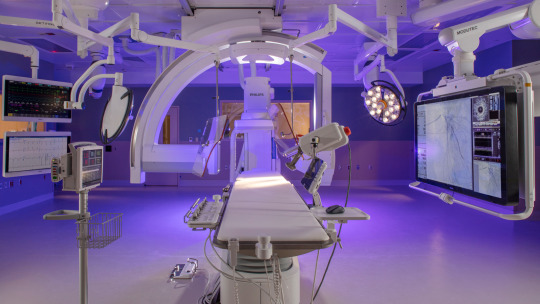
All staff involved in the procedure will be wearing lead-lined aprons, surgical masks, and goggles. In the procedure room, they will move from the bed to a table, or will be assisted if needed, and positioned on their stomach with a pillow under their hips. They will be hooked up to a cardiac monitor and put on an end-tidal CO2 sampling nasal cannula (see the image below).
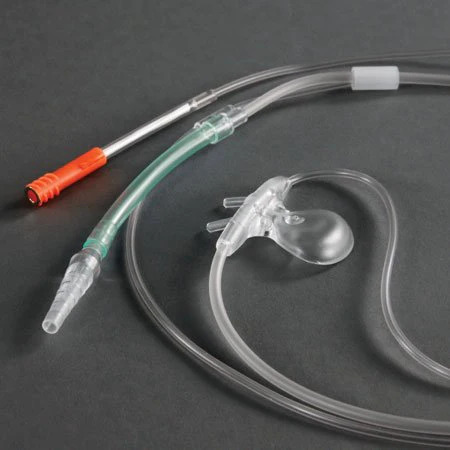
They may or may not be given fentanyl and midazolam (Versed) through their IV for pain relief and mild sedation. They will still be awake and aware during the procedure. I've seen people make small talk with the staff for their entire procedures. The patient will then be draped everywhere except for the site (over one of the iliac crests of the pelvis) of the procedure. The radiologist will inject lidocaine into the skin around the site and clean it with betadine (a disinfectant similar to iodine). The radiologist will then make a small incision at the site and insert a needle containing a fine tube down to the bone (see the image below).
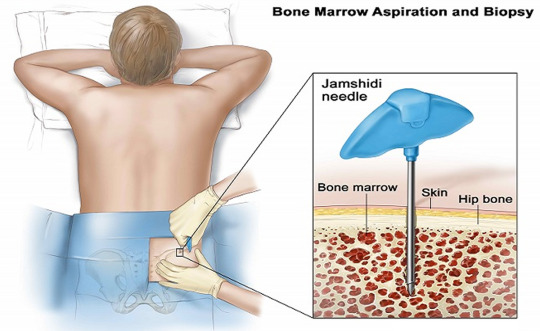
The radiologist will work the needle into the bone with a twisting motion. The patient won't feel pain, but some people have said that the sensation of the needle twisting into the bone can be uncomfortable. When the needle penetrates the marrow, it will be removed, leaving the tube to which a syringe will be attached and marrow drawn up. Patients have reported feeling an uncomfortable sucking sensation during this part. Once this is done, the tube will be removed and a biopsy needle (see the image below) will be inserted into the same incision to take a separate sample.
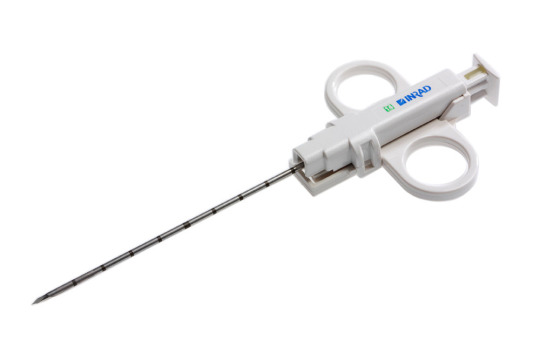
A twisting motion is also used here. The radiologist will then put a pressure dressing on the site. After the radiological equipment has been turned off and the patient disconnected from the monitoring equipment, the staff will move them back to the hospital bed and the nurse will wheel them back to their cubicle in the unit. They will be positioned so that their weight is on the incision to maintain pressure and control bleeding. The patient will stay at the hospital for a few hours while the meds wear off and the nurses monitor them for bleeding, after which they will be discharged with instructions to call the doctor if they experience any excessive bleeding. They should have someone else drive them home.
Bone marrow donation: To be a bone marrow donor, a person has to be between 18 and 35 years old; not have HIV/AIDs, rheumatoid arthritis, systemic autoimmune diseases, bleeding disorders, brain injury, cancer or prior cancer treatments within 5 years of the donation, chronic pain that is treated with medications, chronic Lyme disease, diabetes that requires insulin, heart disease, hepatitis B/C, or kidney disease; and be a match to the intended recipient's human leukocyte antigen (HLA) and blood type. (Note: people can donate to bone marrow banks and be matched anonymously to recipients with their same HLA type) HLA types are different from blood types and are most commonly matched between people of the same ethnic background and family members, especially siblings. The donor will have to undergo extensive tests to ensure that they are healthy enough to undergo the procedure and for their bone marrow to be used for transplant; these include blood tests, tests for all types of infections, an electrocardiogram, and a chest x-ray. Bone marrow stem cells may be harvested from a regular blood donation or from bone marrow aspiration. The procedure for donation is the same as for aspiration, only the patient may be put under general anesthesia and intubated and the doctor will pull off about 1-2 pints of bone marrow. The patient may have to stay in the hospital overnight.
Bone marrow transplant: This is officially called a hematopoietic stem cell transplant (HSCT) and is usually done for leukemia, lymphoma, myeloma, polycythemia vera, aplastic anemia, severe immunodeficiency disorders, sickle cell anemia, beta thalassemia, and other disorders of the bone marrow or immunity. Stem cells can be taken from the recipient before their illness became serious, a related or unrelated donor, or umbilical cord blood. It is often a last resort treatment due to its high cost (up to $500,000) and potential for graft rejection. Before transplantation, the patient will receive high-dose radiation and chemotherapy (myeloablative therapy) to destroy their existing bone marrow. Once the myeloablative therapy has been completed, stem cells will be infused through a central venous catheter (see the image below), which the patient will certainly already have if they have cancer.
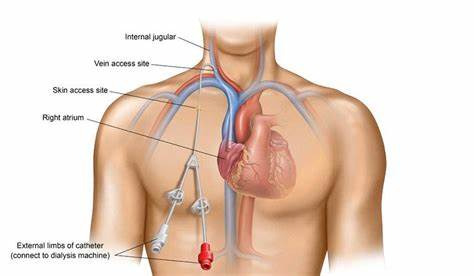
Ideally, the cells will seed in the bones and multiply to fill them (engraftment). This can take 2-4 weeks, or may never occur. The patient may not achieve full immunity for months or years. The patient may be in the hospital from the start of myeloablative therapy to 100 days after the transplant. Following the transplant, the patient will be on a regimen of medications to suppress their immune system to avoid graft-versus-host disease (GVHD; rejection of the donor stem cells resulting in a systemic inflammatory reaction). The patient may or may not be on this regimen for the rest of their life; if they never experience GVHD, they may not. They will have to be on the lookout for signs of graft rejection and secondary cancers (due to the myeloablative therapy) for the rest of their life.
Thanks for letting me nerd out and happy whumping!
#whump#hospital whump#anon ask#🦾#bone marrow aspiration and biopsy#bone marrow donation#bone marrow transplant
9 notes
·
View notes
Note
Neutrophil squad when they're drunk
*le gasp* OMG A CELLS AT WORK NONNIE??
Coming right up!! (sorry if its short but this was fun to write)
Neutrophil Squad when Drunk 🥴
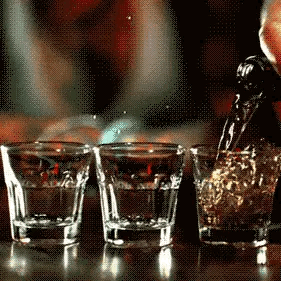
U-1146
The sleepy drunk; tired after four/five shots he's o u t like a light
OR
Gets up on the karaoke stand and starts singing but not good
Its just really bad 🤣
It'd be such a shame if 3803 saw him like that in his pov
he would undergo activation the next day cause you know someone had to tell him
But in reality he has a massive headache and will not get out of bed so hes out of commission poor bb
U-4989
The chatty drunk as in he accidentally spills too much about himself without knowing it ;one of his freinds is going to have to shut him up or hes gonna start a bar figh-
Oh crap, too late hes started a bar fight now he's banned from the bar for life cause it was that bad
Joins 1146 in karaoke lmaoooo
He might have told 3803 that 1146 has a crush on her...immediately forgets everything he has said last night cause he was so drunk lol
Instead of being ashamed of what hes done (a little), few days later he laughs it off cause its all in the past
U-2048
Horny/Flirtier than usual drunk
Tries to hit on every female cell in the bar until 26 strides in and drags him back to where he and his buddies are,
"Hey~26, i bet you have some pretty ass eyes under thise bangs~"
big mistake 2048; when he tries to sweep 26's bangs back he's met with a hard smack to his face 😵 let me insert the streetfighter k.o meme right here

Doesnt wake up and 2626 had to lift the neutrophil over his shoulder to the infirmary
U-2626
He can hold his own pretty good with drinks
Well thats what he thinks until 2048 bursts into his dorm next morning and is throttling him because he sort of made out with him
Now heres how it happened, 2048 doing his annoying round of flirting with the girls, hammered as heck, he drops next to 2626 and whines about hs lack of bitches and he was getting about tired of it, so he took another shot and then kissed him straight on the mouth
Annnnnd let me just say it led into a messy make out session in the bathroom until 2048 had to excuse himself and frew up
Does 26 regret doing that?....a little but at least it shut him up
Gay awakening??🤔
U-2001
The sober one who has to take them all home in the end lolol
Just has two/three drinks (some water on the slide) but has to keep an eye on everyone
*rolls his eyes whilst literally wheeling out four plastered neutrophils on a cart that the red blood cells use for carrying oxygen* 🤣🤣🤣
#cells at work#hataraku saibou#caw headcanons#neutrophil squad#u2001 just sighs cause hes so tired of doing this lol#white blood cell#u4989#u1146#u2626#u2001#u2048#drawers ask event 🥳
18 notes
·
View notes
Note
Opinion on how cells at work handled cancer cells? Also just general opinions on it I'd love to hear them
I'm reeeaaally glad they took cancer cells as a tragedy and not as another monster of the week type of situation, there's a lot of things you can do with cancer narratively from its biology.(My favorite one from this "genre" has to be Shin godzilla, if you, like me, take Godzilla to be much like a walking teratoma, uncontrollable growth of cells that do anything to survive) I also try to do the same thing with my own OC lore of weird flesh angels
Just wished they developed more though... cancer, as a metaphor, (to me) speaks of sympathy for the other, it's an ugly duckling kind of situation. You were born monstruous, this was not your fault (nor it is anyone else's), and for that you must die. You can try to fit in (as the cancer in the anime did for like, 10 minutes) but the attempts come off more of a caricature of normalcy than anything else, like some sort of alien wearing human skin, an alien who will eventuall grow larger than the skin it wears. They seem to hint at this at some point, but never go in depth about it, but then again I'm not used to quick forms of media, they had a short 23mins to do it so I'm not gonna dwell on it
But Cells at work does mostly focus on the biological part which is fine (and mostly the appeal), sure it's not Cancer's fault for being born this way, but its presence is an attack to the homeostasis of the body, it needs to get rid of it. In a biological sense it's hard to defend Cancer. rip.
I wished NK and T CD8 did more in this episode, especially NK who is the one most responsible for handling cancer cells (and for the record so do neutrophils, but they seem to do a minor work in cancer cells.)
A veeeery very small detail I liked about the final scene is the Cancer being able to stop the Neutrophil with just saying 'Stop', advanced cancers can soothe and control the innate immune system to survive, and they took this little detail so well to discuss the relationship of cancer and the body
As for the anime, it's fine? I don't watch many animes OTL the choice to make the main WBC guy a neutrophil is interesting, and personally to me I think macrophages should take a much much larger screentime, they do most of the important things and they are sentinel/patrolling cells unlike neutrophils, which are just activated when there's an infection (do not take this as me hating on neutrophils; i dont!! I have a neutrophil tattoo... theyre my favorite granulocytes)
ALSO fun fact! Some cancers are so good at surviving that they become entire new organisms, they are known as transmissable cancers, the most known type of this cancer is the CTVT (canine transmissable veneral tumor)
it's interesting to note that since this is a cancer that became 'independent' and it was originally a dog cell, you can say that it **theoretically** is an single-celled dog, given that it might still contain the dog genome, just corrupted! There are other types of organisms that evolved from cancer, some are interesting for lacking mitochondria within them
#[ask and be awnsered]#SOOOORY FOR THE RAMBLING I HAVE ALOT TO SAY WHEN IT COMES TO IMMUNOLOGY!!!!#i think a good example of this is INSIDE by playdead#if you read it as a cancer metaphor#but personally to me Shin godzilla is my favorite cancer metaphor#i could do an entire post about it
9 notes
·
View notes
Text
The 40: Catch the Bullet

"To answer your question, you get to be a superhero by believing in the hero within you and summoning him or her forth by an act of will." - Adrian Veidt/Ozymandias
----
@the-ravenclaw-werewolf, @purplemochi20055, @hulkchloron99, and @r3dp4nd4ch1ld
----
I decided to bust out my drawing tablet and use Photoshop again to create a comic for The 40, and I will say...it's a start for me to brush up on my digital illustration skills.
Izuku has come a long way after his year-long intense training regiment compared to his Pre-Character Development self. But the most gracious physical feat he had performed that would make Bakugou jealous and All Might proud, was being able to catch a bullet fired from a revolver.
I was looking over Alan Moore's well-known comic, Watchmen, and was greatly interested in Ozymandias' character and the astonishing physical and mental feats he's able to perform after dedicating himself to training his mind and body by retracing the steps of Alexander the Great by traveling the world. The one thing that interests me about how he managed to become what he is, is through his interview in the second to last issue. Where Adrian firmly believes that anyone can do what he can achieve, as you need to have the belief and willpower to see it through.
And what do you know...Izuku manages to do the impossible after the many trials that await him in the year-long intense training regiment. Reacting immediately upon seeing an unknown assailant pull a revolver on him, and summoning all of his willpower and technique to time his catching of the bullet correctly. However, like with Ozymandias, Izuku's skin was damaged from the bullet due to the obvious friction from the speed it had. But it's still a great accomplishment compared to his pre-training self, as the bullet would've burst through his hand and killed him, never mind the idea that he could actually catch it.
----
Afterward reaction from the other members of The 40.
Spike Spiegel: Shhiieeeeeeeeettt kid...you actually caught it...
Levi Ackerman: Well I'll be damned...
Zuko: Izuku...you did it.
Korra: That...was the most craziest thing you have ever done.
Saitama: ...Good for him...
Mob: That was close!
Edward Elric: How is that possible?
Ishigami Senku: That can't be scientifically possible!
Gojo: Bwa ha ha ha! Amazing!
Hanako: That was close.
Souma: Holy crap!
Mako: Whoo hoo Izuku-kun!
Kobayashi: That was too close for comfort!
Tohru: (worryingly) Izuku-kun!
Chika: Hmm...I must keep a close eye on this one.
Haruka: ...Huh...
Naegi Makoto: He actually caught it!
Ciel Phantomhive: That was...impressive...
Katsuki Yuuri: That took some insane reaction speed.
Shouyou Hinata: Go for it Izuku!
Saiki Kusuo: I knew he would catch it. Looking at you Omnitheist27.
Suzui Ryōta: I wouldn't take a gamble like that.
Heine Wittgenstein: He has come a long way.
White Blood Cell / Neutrophil (U-1146): The medulla oblongata must be very active for him to do that.
Satō Mafuyu: ...
Hasegawa Langa: ...
Killua Zoldyck: While impressive for someone like Izuku, I've seen greater reaction time.
Kamado Tanjirou: Yeah! Izuku-san!
Kuroko Tetsuya: ...
Okumura Rin: I've got to train harder if I want to do that.
Fujioka Haruhi: That really was close.
Emma: Go Izuku!
Serinuma Kae: I've got to read Observepeople again!
L: To possess the will needed to pull that off...
Shiota Nagisa: I'm not sure if I want to do that...
Legoshi: So humans are capable of such feats.
Suzuki Iruma: I wonder if learning to catch a bullet would come in handy for school?
Fujinuma Satoru: That...is something you don't see every day.
Feliciano Vargas (North Italy): I'm starting to get flashbacks of Japan wanting to cut bullets.
----
Canon MHA cast reaction:
Midoriya Inko: (bawling) IZZUUUUUKKUUU!!!
All Might: (in English) Oh my...oh my...GOODNESS!!!
Bakugou Katsuki: Tch! I would've caught it as well!
Uraraka Ochako: You did it Deku-kun!
Iida Tenya: WHILE I WOULD NEVER RECOMMEND SUCH ACTION, I WILL ADMIT MIDORIYA-SAN'S EFFORT!
Todoroki Shouto: Midoriya...
Asui Tsuyu: That was reckless Midoriya-san, but good job.
Mineta Minoru: HE'S INSANE!!! Although he was pretty cool.
Kirishima Eijiro: MANLY!!!
Shinso Hitoshi: Could I do that...
Togata Mirio: POWER!!!
Izumi Kota: Kick his ass Izuku!
Eri: D-D-Do your best Deku!
Shouta Aizawa: (to the rest of Class 1-A) If I catch any of you performing a stunt like that...
17 notes
·
View notes
Text
Fungal microbiota sustains lasting immune activation of neutrophils and their progenitors in severe COVID-19 | Nature Immunology
We found that elevated levels of Candida albicans immunoglobulin G (IgG) antibodies marked patients with severe COVID-19 (sCOVID-19) who had intestinal Candida overgrowth, mycobiota dysbiosis and systemic neutrophilia.
...
These findings suggest that gut fungal pathobionts may contribute to immune activation during inflammatory diseases, offering potential mycobiota-immune therapeutic strategies for sCOVID-19 with prolonged symptoms.
study in Nature Immunology suggests that an excess of certain gut fungi, including Candida albicans, may contribute to severe COVID-19 or long COVID-19 through inflammation; antifungal treatments in mice showed potential in alleviating these effects.
study in Nature Immunology suggests that an excess of certain gut fungi, including Candida albicans, may contribute to severe COVID-19 or long COVID-19 through inflammation; antifungal treatments in mice showed potential in alleviating these effects.
#covid#long covid#research#study#nature journal#candida albicans#fungus#gut microbiome#microbiome#candida#fall 2023
33 notes
·
View notes
Text
Complement system
1. Activation: The complement system can be activated through three main pathways: the classical pathway, the alternative pathway, and the lectin pathway. Each pathway involves different initiating events but converges on a common cascade of reactions.
2. Cascade of Reactions: Once activated, the complement system triggers a cascade of enzymatic reactions that result in the cleavage of complement proteins. This cascade ultimately leads to the formation of several key components, including C3b, C4b, and C5b.
3. Opsonization: C3b and C4b are opsonins, which means they can bind to pathogens and label them for phagocytosis by immune cells like macrophages and neutrophils. This enhances the removal of pathogens from the body.
4. Inflammation: Complement activation also results in the release of small peptides called anaphylatoxins, such as C3a and C5a. These peptides promote inflammation by increasing blood vessel permeability and attracting immune cells to the site of infection.
5. Membrane Attack Complex (MAC): The final step of complement activation involves the assembly of the membrane attack complex (MAC). C5b, C6, C7, C8, and multiple C9 molecules come together to form the MAC, which can create pores in the membranes of target cells, leading to cell lysis and destruction of pathogens.
References:
1. Walport, M. J. (2001). Complement. First of two parts. New England Journal of Medicine, 344(14), 1058-1066.
2. Ricklin, D., Hajishengallis, G., Yang, K., & Lambris, J. D. (2010). Complement: a key system for immune surveillance and homeostasis. Nature Immunology, 11(9), 785-797.
3. Merle, N. S., Church, S. E., Fremeaux-Bacchi, V., & Roumenina, L. T. (2015). Complement system part I – molecular mechanisms of activation and regulation. Frontiers in Immunology, 6, 262.
Please note that for the most current and detailed medical information on the complement system, I recommend consulting recent textbooks or academic journals in immunology and microbiology.
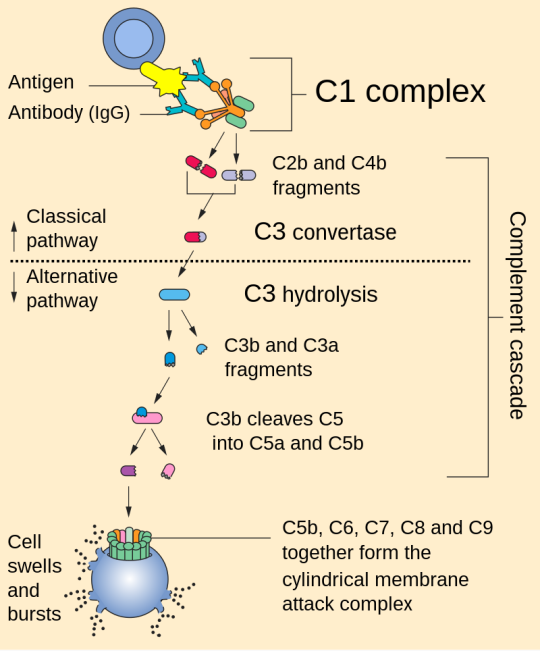
#science#biology#college#education#school#student#medicine#doctors#health#healthcare#immunology#immune system#complement system
50 notes
·
View notes
Text

TSRNOSS, page 73.
#superoxide#neutrophils#island#lake victoria#rainfall#ozone#asthma#uganda#grasslands#tse tse fly#ultrasound#brittle material#enzyme activation#papain#bromelain#lipase#cursive#handwriting#manuscript#journals#notebooks
0 notes
Note
No, no, please, go on, S. Aureus has my attention and I wish to know more...
anon you have my eternal gratitude for your continued interest.... WELL what i cut myself off on talking about was the virulence factors! aka what s aureus Has That Makes It Toxic. well first off it can release a bunchhh of enzymes that degrade the environment around.. like it Literally has a desoxyribonuclease to break down DNA! (little shorthand--anything that ends in -ase is usually an enzyme, aka it Breaks Down Something). it can also secrete a bunch of toxins like! superantigens!
so an antigen is what an immune cell recognizes to go Oh this thing is a stranger to our body! we have to destroy it! and those interactions are Specific like different lymphocytes have different Specificities in the antigens they can recognize. a SUPERantigen is one that bypasses those specificities and just activates a MASS amount of lymphocytes. and sure immune cells are there to protect us but there's a balance to maintain! when there's a mass reaction like that it overbalances into toxic shock syndrome (yk .... what they scare you with so you don't keep your tampon in too long). basically your whole body goes into crisis mode.
they can ALSO! do DNA repairs! because neutrophils (a type of immune cell) can attack s aureus with ROS (reactive oxygen species). these ROS loveee DNA its their favourite thing so they will go connect to DNA and cause single or double-strand breaks. and s aureus have a complex that fixes those on the spot.
yeah <3 thats it for your s aureus lesson.. go out into the world with this knowledge. do whatever you want with it
3 notes
·
View notes
Text
Reference saved in our archive
Abstract Background The production of inflammatory cytokines is reportedly increased in patients with coronavirus disease 2019 (COVID-19), causing the migration of neutrophils and monocytes to lung tissues. This disrupts the air–blood barrier by damaging the bronchial epithelial and vascular endothelial cells. As multiorgan dysfunction in sepsis is considered to be partly caused by complement activation, which can cause lung injury in patients with COVID-19. There are limited studies examining the link between complement activation in patients with COVID-19. This study aimed to AQinvestigate the association of complement activation with the pathophysiology of COVID-19. Twenty-seven patients with COVID-19 were enrolled in this study and classified into two groups depending on the indication for mechanical ventilation. Plasma complement factors (C3a, C5a, Ba, and sC5b-9), complement regulators (sCD59 and factor H), interleukin-6 (IL-6), and syndecan-1 levels were measured using Enzyme-linked immunosorbent assay (ELISA). Results: All complement factors and regulators, IL-6, and syndecan-1 levels were significantly elevated in patients with COVID-19 compared with those in healthy controls. C5a and sC5b-9 levels were decreased significantly in the invasive mechanical ventilation (IMV) group compared with those in the non-IMV group. Syndecan-1 levels were significantly increased in the IMV group compared with those in the non-IMV group. Conclusions: Complement activation is an exacerbating factor for lung injury in patients with COVID-19. Complement factors are nonessential predictors of mechanical ventilation; however, syndecan-1 could be a biomarker of COVID-19 severity in patients.
#long covid#covid conscious#mask up#covid#pandemic#public health#covid 19#wear a mask#wear a respirator#still coviding#coronavirus#sars cov 2#covid is airborne#covid is not over
24 notes
·
View notes
Text
Random headcanons I think of sometimes (Oops! All Friends spinoff)
Dendritic cell doesn't get his cytokine material himself, he employs the M cells in the bars to capture the most horrendous images of immune cells while they're all intoxicated (he wears a feather boa when he's activated <3)
Canon but I don't think a lot of people know, he has good voice acting skills with his singing + narration being pretty good
Leaves his plushies everywhere. Gave one to M cell to see if it'd cheer him up, it did because M cell was happy he tried helping him. Dendritic cell thought it was just because of the cuteness and purity of the lactic acid bacterium
He visits M cell so much, every time M cell rings up the dendritic cells for antigen presentation it's always our beloved Dendritick cell that comes to his bar to get it
Dendritic cell also started out absolutely terrified of bacteria, had to practice very hard with antigen presentation
There is written fiction of the neutrophils, probably a lot of BL let's be real
There is a popular book that is like Twilight but with those weirdos
All neutrophils except for 2145 have colored hair and eyes, I will not elaborate
More of a general thing rather than only friends, but neutrophils definitely have sharper teeth compared to non phagocyte cells
2145 goes to work everyday even on his off days, it's for a free lunch
2145 eats the body of cells right in front of other cells without thinking of the implications, he is enjoying the snack.
His favorite past time is listening to 1235 talk about her day, she is like a radio for him
3033 doesn't have a single creative bone in his body, you ask him to draw something and it barely even looks like what you wanted. He wears all white all the time because he doesn't know what outfits look good with what color, it's terrible.
Squad Leader would kill himself if he knew, but 3033 dislikes him. It's not for any particular reason, they just don't mesh well. It's okay since Squad Leader doesn't bother 3033 a lot anyways
Canon but I never realized this in 3 years of reading this manga: 3033 doesn't wear his knife straps on his legs if it isn't necessary to use those knives, only wears them when he needs to fight something dangerous.
M cell low-key has trouble eating enough because of his depression. You can directly counter this by getting him foods that expire within a day or two, he hates wasting food so he eats it before it expires.
Actually canon again but I need more people to know: M cell can make balloon animals
The fact that M cell has a lot of random skills in general, I wouldn't he surprised if he knew how to make stained glass art or could do wood carving
Cross reads the smuttiest, most vile BL stories as a past time. If you find his stash he will go insane.
He also enjoys talking to 1235 about squad leader (and then later on about 3033, girl talk)
1235 befriends so many immune cells because just like AE3803 from Main, she is a danger magnet. Everytime she is saved from an immune cell she makes small talk with them no matter how introverted they are (see 2145, NK and Eosinophil)
Helper T cell doesn't remember anything from his thymus days because it was so traumatizing he just blocks out those memories. It's not that he doesn't recognize Squad Leader, it's that his mind won't let him remember.
Squad Leader physically cannot hit another cell without orders, he can hit HT because Squad Leader is filled with so much rage every time he sees HT he just gains the strength to do it.
Also a general HC but I think Reg T cells in general have major face blindness. Unless you're someone close to them they will not recognize you once you do a change of clothes, but it's okay, as long as you still have the right receptors for the body they will protect you.
Eosinophil regularly visits M cell's bar because not only is it good practice for her with minimal casualties (poor M cell) but also it's an unpopular bar so she doesn't need to be so anxious.
B cell tried to hit on Eosinophil exactly once (1) and stopped because she exploded from anxiety and B cell thought she hated him so much she'd rather explode than talk to him
B cell and M cell don't like each other a lot, M cell thinks he's too loud, and B cell thinks he's too much of a downer. Partly the reason why Memory cell visited his bar alone without B cell
If you put NK and Eosinophil in the same room alone, they would just not talk. No conversation between those two. NK thinks Eos is judging her but Eos thinks NK doesn't like her and doesn't want to talk to her.
B cell and Mast cell get along surprisingly well (ignore how in canon Mast cell says he'll never talk to him again if he insults his gacha game girlies again), B cell talks about the pretty cells he sees regularly on the job while Mast cell show him his anime girls. Mutual respect until B cell is like "Well I prefer girls you can actually touch in the real world" in which Mast cell will tell him to shut up
#cells at work#hataraku saibou#hataraku saibō#cells at work friends#caw friends#hataraku saibo friends#headcanons
13 notes
·
View notes
Text
SO I WAS PLAYING WITH A PICREW AND HAD A BRAINWAVE
i present to you…
cells at work ✨MAGIC AU✨
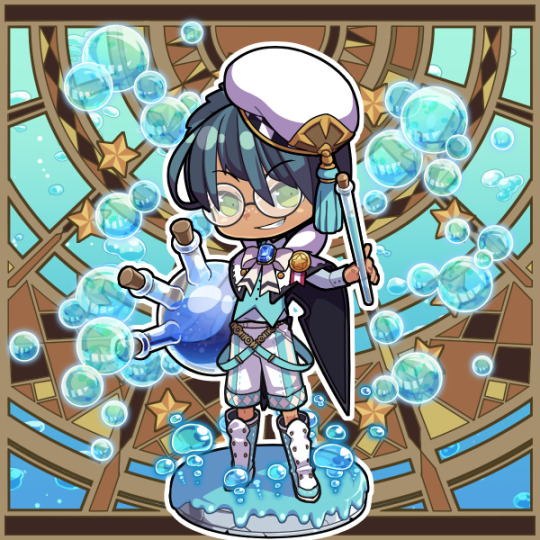
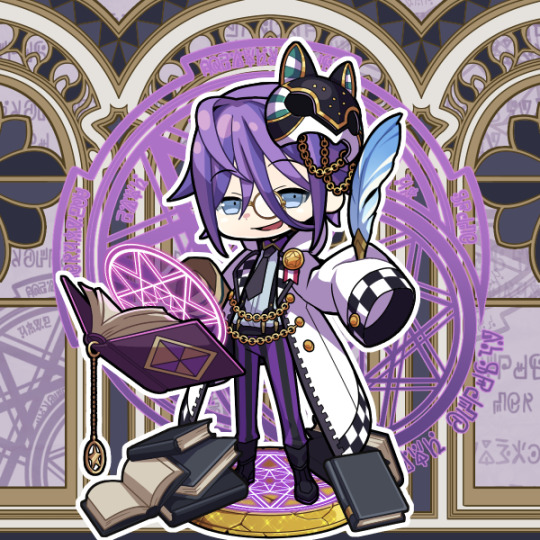
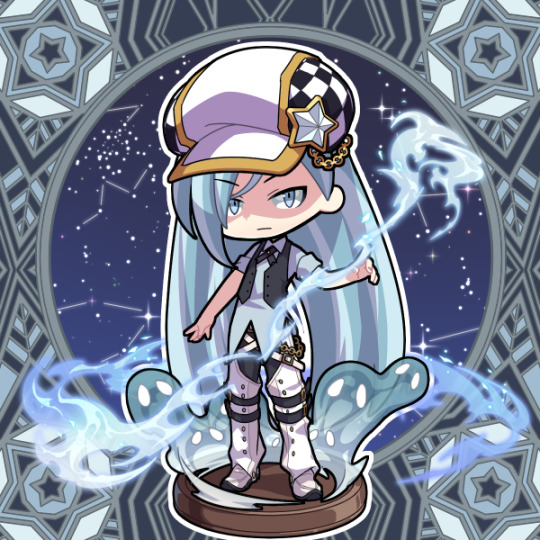
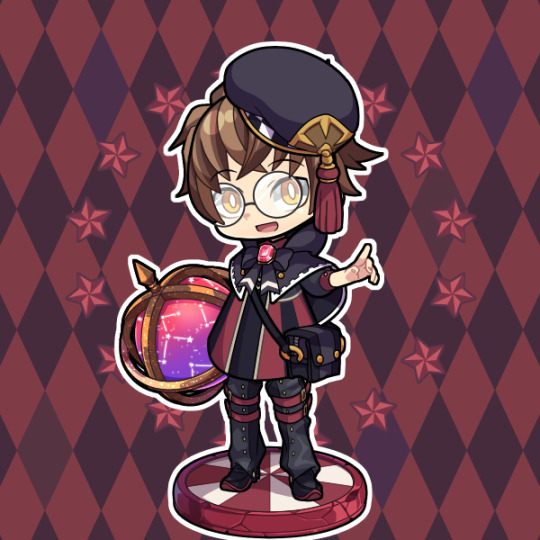
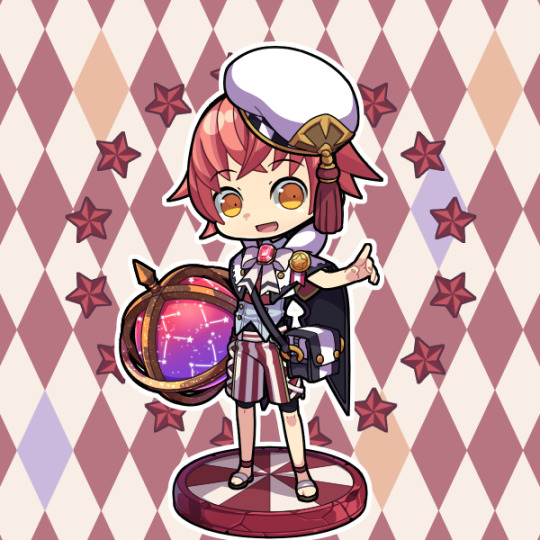
ok i know this may sound absurd (and not medically accurate at ALL) but hear me out
picrew link btwwww: https://picrew.me/en/image_maker/22819
ramble under the cut:
The Body
The Body is a vast magical kingdom inhabited by many different types of Cells (what the inhabitants of this world are called). The Cells work in tandem to keep their kingdom up and running, with each cell having their own unique role to play. Monsters sometimes come through rips in space-time that sometimes appear in the sky, or through the portals which the kingdom attains its fuels and nutrients its needs to survive. So, the Cells have to be ever vigilant against these foreign invaders lest they seek a bit of their flesh too.
Here are just some of the residents of this strange world:
B-Cells (also known as Plasma Cells)

(this is my oc, b-1808…)
B cells are magic warriors who shoot holy/magic water (antibodies) from their palms at monsters (bacteria) to vanquish them. basically hydrokinesis but antibodies! They are often seen with Memory Cells in battle, who I will elaborate more on in the next part:
Memory B Cells (or just memory cells)

(this is my other oc, N-1712)
Memory Cells are long-lived acolytes that dedicate their entire lives to studying past attacks on the kingdom by foreign invaders and remembering information on them to help the immune system (The Body’s defence force, basically) fight them off better in the future.
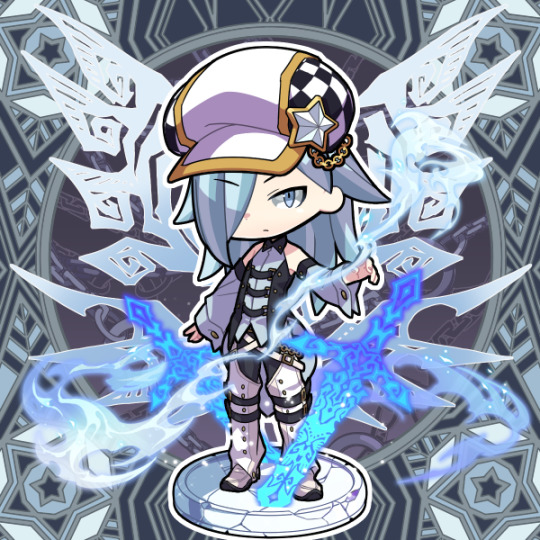
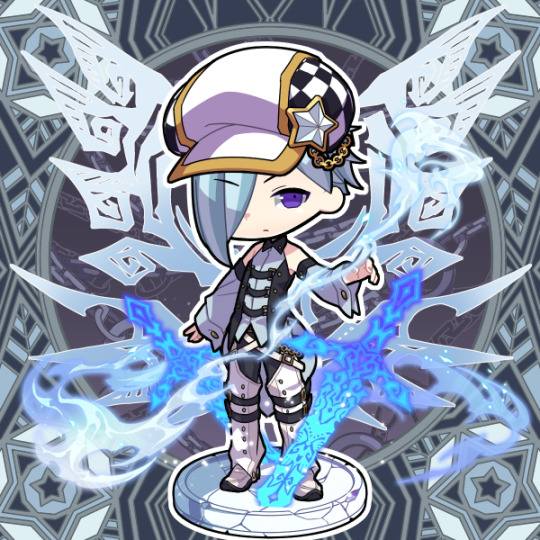
1196 and 1146 respectively! (i’m sorry they didn’t have black eye color so i had to settle for the darkest which was purple 😭
Neutrophils (more commonly known by the umbrella term White Blood Cells) are ghost-like warriors who can warp their body into a cloud of mist-like substance to engulf bacteria, destroying them from the outside in. This often grotesque process is known as phagocytosis. Many of them also carry with them blades to subdue their opponents before “eating” them. The morbidity of the way they fight leads many cells in the body to be afraid of them, and this is the reason why there is a lot of stigma and discrimination surrounding Neutrophils.
Red Blood Cells (also known as Erythrocytes)


aa1253 and ae3803 ^^
For a long time, it was thought that Red Blood Cells were just ordinary cells who just so happened to like the colour red way more than the average Cell does. Turns out, they’re the only race of Cell who can carry one of the most important fuel substances for The Body to sustain itself— Oxygen. Many other cells simply cannot even handle this curious substance, with it slipping between their hands like air, but only, and only Red Blood Cells seem to carry it with ease. That is why they run around The Body, delivering Oxygen that comes from The Lungs, to other organs who need this vital resource to keep running.
Not only are Erythrocytes couriers of Oxygen, they possess a curious ability to kill off foreign invaders using the oxygen they have on hand— if any Erythrocyte is brave enough to walk up to a bacteria to challenge it, anyway. This process has been coined Oxycytosis, though many Red Blood Cells dislike doing this as it robs them of their precious oxygen and they have to go all the way back to The Lungs to get another batch of it.
Macrophage

Macrophages live complicated lives. For one, you can see them caring for and raising young blood cells in the nurseries of the Bone Marrow, but then you can also find them around the body ruthlessly killing off any foreign invaders who dare to harm the body they reside in. They have the ability of phagocytosis too, though it is not as well known as Neutrophil’s phagocytosis.
Dendritic Cell
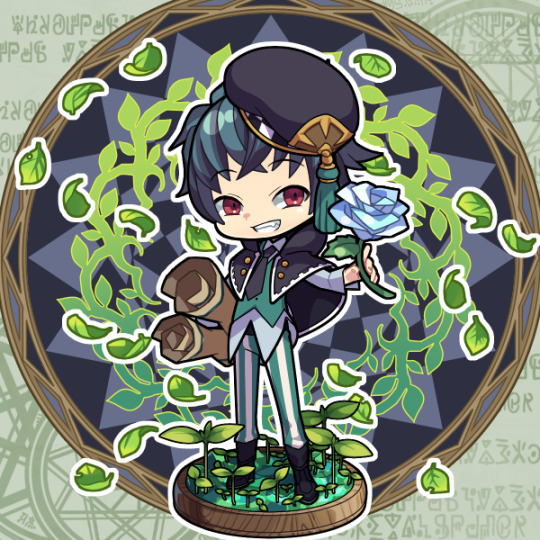
These kinds of cells are kind of like messengers, relaying information between the active and innate immune system, like from Macrophage to Helper T Cell. They can be activated using Polysaccharides made from Lactic Acid Bacteria, and that allows them to in turn, activate other cells, releasing cytokines to “motivate” them to fight harder.
It is noteworthy that they also possess some fighting capability themselves, as immune cells, so they are not one to be kicked around!

Eosinophil’s phagocytosis and Bacteria/Virus fighting capabilities may pale in comparison to those of other immune cells, but don’t underestimate her. She eliminates a whole different kind of pathogen other white blood cells can’t eliminate— parasites, like Anisakis etc.
Ok that’s it i’m tired you get more another day bye
13 notes
·
View notes
Text
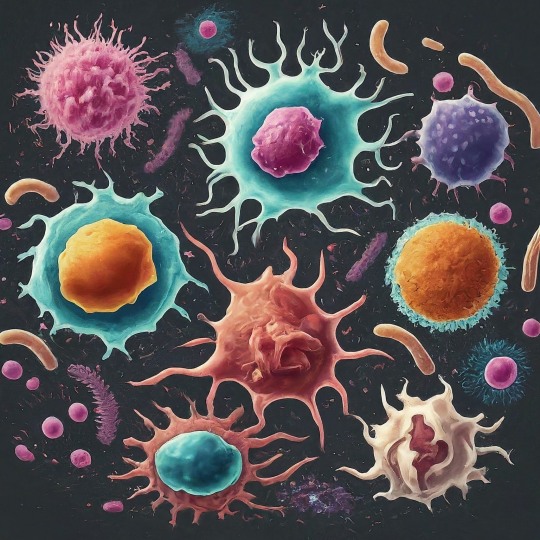
The Immune System's All-Star Team: The Mighty Cells That Protect You
Your body is like a bustling city, constantly facing threats from outside invaders like viruses and bacteria. Thankfully, you have a team of dedicated defenders keeping you safe: your immune cells! Our immune system is a marvel of biological defense, tirelessly safeguarding our bodies from harmful invaders like bacteria, viruses, and parasites. At the forefront of this defense are numerous types of immune cells, each with its unique functions and capabilities. Did you know the average adult has about 2 trillion white blood cells, which contain most immune cells? That's more people than live in China! These tiny warriors come in different shapes and sizes, each with unique superpowers to protect you. Let's meet some of the key players:
The Innate Force: First up, we have the innate immune system. This frontline defense acts fast and nonspecifically, providing immediate protection against any threat. The key players: 1. Neutrophils: Think of these guys as the city's SWAT team. They're the first responders, rushing to attack invaders with toxic chemicals and swallowing them whole with their arsenal of enzymes! These are the most abundant immune cells, are short-lived but highly effective. Unfortunately, they die in the fight, leaving behind a green gooey mess (pus) that signals infection.
2. Macrophages: These are the veterans, the wise generals of the immune system. They go beyond mere engulfing, processing antigens (foreign molecules) and presenting them to other immune cells for recognition and attack. They also act as scavengers, cleaning up debris and orchestrating healing. These are the cleaners and recyclers. They gobble up dead neutrophils, debris, and even worn-out cells, keeping your city sparkling clean.
3. Natural Killer (NK) Cells: These are the ninjas of the immune system. They silently patrol, sniffing out suspicious cells infected with viruses or even cancer and eliminating them with a swift punch. The Adaptive Arsenal:
The Adaptive Arsenal: If the innate system fails, the adaptive immune system steps in. This highly specific defense remembers past encounters and tailors its response to each unique threat. The cells of adaptive immune system are:
B Cells: These are the antibody factories, producing highly specific proteins called antibodies that neutralize pathogens and toxins. Each B cell produces a unique antibody, like a lock and key, targeting specific invaders. They whip up special proteins called antibodies that lock onto specific invaders, like sticky notes, marking them for destruction.
T Cells: These are the generals, coordinating the entire defense. There are different types of T cells:
Helper T Cells: These are the commanders, directing and coordinating the immune response through chemical signals. They activate B cells, macrophages, and other immune cells, orchestrating a multi-pronged attack.
Cytotoxic T Cells: These are the elite soldiers, directly targeting and eliminating infected cells or cancer cells. They recognize and bind to specific enemy markers, unleashing a lethal attack.
Memory T Cells: These are the veterans, remembering past encounters with invaders and helping the immune system respond faster next time.
The Unsung Heroes: Beyond these main players, numerous other immune cells contribute to our defense. These include:
Dendritic cells: These antigen-presenting cells capture and process pathogens, presenting their fragments to T cells for activation. They're like the scouts, gathering enemy intel and relaying it to the command center.
Mast cells: These cells reside in tissues and release inflammatory chemicals in response to allergens or parasites. They're like the alarm system, alerting the immune system to local threats.
Eosinophils: These specialize in fighting parasitic infections, releasing toxic chemicals to neutralize them.
Basophils: These are involved in allergic reactions and contribute to wound healing.
The beauty of the immune system lies in its intricate collaboration. These diverse cell types work together in a complex and beautiful dance, each playing a specific role to achieve a common goal: protecting our health. They communicate extensively through chemical signals, creating a complex network of interactions. Imagine B cells producing antibodies that bind to a pathogen, flagging it for destruction. Macrophages engulf and eliminate the tagged pathogen, while T cells coordinate the attack and eliminate any infected cells. Dendritic cells present captured fragments to T cells, priming them for future encounters. This seamless cooperation ensures a swift and effective response to any threat.
Your immune system is constantly learning. Each time you get a vaccine or fight off an infection, your immune cells create memory T cells, making you more resistant to future attacks. Understanding these cellular heroes can help us appreciate the incredible machinery that keeps us healthy and appreciate the importance of maintaining a strong immune system. It also allows us to make informed decisions about supporting our immune system. Maintaining a healthy lifestyle, getting adequate sleep, managing stress, and consuming a balanced diet can all contribute to a robust immune response.
#science sculpt#life science#science#biology#biotechnology#artists on tumblr#immunology#immunotherapy#immune cells#b cells#t cells#neutrophil#macrophages#immunity#health and wellness#medicine#healthcare#illustration#illustrative art
9 notes
·
View notes
Note
Because you said to ask about basophil I will put a few random character related questions here
What are his hobbies?
What’s his best memory?
What’s his worst memory?
Favorite headcanon(s)?
Favorite thing(s) about him in canon?
Also just put facts about the basophils you find interesting if you also wanna talk about the actual cells too idk
-Sunheart
Well, main basophil canonically likes to fish but I also like to believe there is one mast cell he likes to bother, since the two contain granules that activate the other. I see them having the relationship you have with a cousin your age. Joking and trying to one up the other.
His best memory would most likely be when he gets to beat up a B cell because those were HIS histamines and he ISNT letting mast cell take credit.
His worst is probably as a myelocyte, he fell into the lake. He has not learnt his lesson since <3
There isn’t a lot of other headcanons but my favorite is that the weapon is like a mist inside the umbrella, like the undercover from splatoon
And my favorite canon fact? Just that he canonically speaks poetry because he’s a dork, and that’s the only reason.
Fun facts? the most likely reason basophil covers himself fully up is a reference to the fact that basophil granules nearly obscure the nucleus! It’s also debated if they are phagocytic, so far they’re seen as unprofessional phagocytes, making them different then their eosinophil and neutrophil counterparts. They are also responsible for helping produce IgE meaning that they work with both Mast Cells and B cells to completely destroy the one pollen allergen that entered your eye.
6 notes
·
View notes